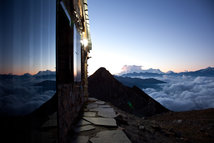Mont-Blanc area
Countries: France , Italy , SwitzerlandRegions concerned: Departments of Savoie, Haute-Savoie (France); Valle d'Aosta (Italy); Canton of Valais (Switzerland)
Presentation
The Mont-Blanc area straddles the regions of "Savoie" and "Haute-Savoie" in France, the "Valle d’Aosta" in Italy and the "Canton of Valais" in Switzerland. This internationally known cross-border territory stretches over 220,000 hectares and covers 35 municipalities, with a total population of 100,000. On the initiative of the local and regional authorities of the three countries, plans for an international nature park resulted in a sustainable development approach for the mountain range. The partners, who cooperate today within the “Conférence transfrontalière de l’Espace Mont-Blanc”, intend to equip their cross-border territory with a legal status, in the form of an EGTC.
The structuring of this territory began in 1988 when plans for a Mont-Blanc international park were explored. From the 1990s onwards, the management of this cross-border territory has been undertaken by the local and regional authorities, with the establishment of the informal political structure, the “Conférence transfrontalière Mont-Blanc”, in 1991.
In general, the Mont-Blanc area supports mountain agriculture and pastoral activities. It is also developing a joint strategy for nature and landscape conservation, encourages integrated tourism compatible with the protection of the environment, and works towards limiting the impact of transport and its infrastructure on the environment. The Mont-Blanc area has carried out numerous studies and taken concrete measures in the field of natural and cultural heritage management.
Following a first sustainable development plan for the Mont-Blanc area, a decision-making aid produced in 2005 an integrated cross-border plan (PIT) within the framework of the ALCOTRA programme1. Twelve million euros were invested in 2013 on six priority cross-border topics: environmental management of the mountain area, renewable energies, public transport, hiking, environmental education and local products.
In order to ensure the continuation of the actions and be recognised as central partner in the cooperation, the "Espace Mont-Blanc" intends to establish its legal status and introduce effective governance instruments. In practical terms, the preparation of a French-Italian-Swiss management plan is one of the major objectives. Another is to provide a legal instrument for the cooperation organisations, in the form of an EGTC, in order to be able to amplify actions and optimise resources in the service of the sustainable development of this “outstanding” area.
In the desire for continuity of recognition, in December 2018, the Mont-Blanc Cross-border Conference positioned itself in favour of a nomination of the Massif as a UNESCO World Heritage Site as a "Cultural Landscape".
- A specific feature of the ALCOTRA programme is the definition of three types of project: simple projects, strategic projects and PITs. On the French-Italian border, seven PITs define multi-topic project packages with the common objective of economic and social development for a territory of a specifically cross-border nature.
Photo copyright: Andrea Alborno


